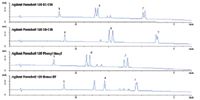Fast Screening Methods for Steroids by HPLC with Agilent Poroshell 120 Columns
Selectivity is the most powerful tool to optimize separations in HPLC. This parameter is changed by using different bonded phases or by changing the mobile phase. In this work, Poroshell 120 columns with highly efficient 2.7 ?m superficially porous particles and the Agilent 1260 Infinity Series LC Multi-Method Solution were used to quickly evaluate method development choices for the analysis of steroids.
Selectivity is the most powerful tool to optimize separations in HPLC. This parameter is changed by using different bonded phases or by changing the mobile phase. In this work, Poroshell 120 columns with highly efficient 2.7 µm superficially porous particles and the Agilent 1260 Infinity Series LC Multi-Method Solution were used to quickly evaluate method development choices for the analysis of steroids. Four columns were evaluated, all 2.1 × 100 mm. The short column length and high efficiency provided short analysis times and rapid equilibration leading to fast investigation of selectivity.
Experimental
The Agilent 1260 Infinity Series LC Multi-Method Solution consists of:
- 1260 Infinity Binary pump (G1312B)
- 1290 Infinity Thermostated Column Compartment (G1316C)
- 1260 Infinity High Performance Autosampler (G1367E)
- 1290 Infinity Diode-Array Detector (G4212A), equipped with 10 mm MaxLight cartridge flow cell
- G6140 Single Quadrupole Mass Spectrometer
The system is highly flexible and can be used for up to four (100 mm) columns. The TCC was fitted with a 6-position/14 port column selection valve. Four Poroshell 120 columns were used, all 2.1 × 100 mm: Poroshell 120 EC-C18 (p/n 695775-902); Poroshell 120 SB-C18 (685775-902); Poroshell 120 Bonus-RP column (p/n 685775-901) and Poroshell 120 Phenyl-Hexyl (p/n 695775-912).
Column Choice to Enhance Selectivity
The columns were chosen to improve selectivity in the separation. They included a highly end-capped column recommended as a first-choice in method development (Poroshell 120 EC-C18), and a non-end-capped C18 (Poroshell 120 StableBond SB-C18) that could have interaction with the silanol groups to provide an alternative C18 selectivity using neutral to low pH mobile phases. A polar-embedded amine column (Poroshell 120 Bonus-RP) and a phenyl-hexyl column (Poroshell 120 Phenyl-Hexyl) were also used. Phenyl bonded phases are known for their improved selectivity for aromatic compounds.
A polar-embedded group inserted into the hydrophobic C13 alkyl chain allows the Bonus-RP phase on totally porous Poroshell 120 to minimize interaction of polar samples with silanols, providing symmetrical peaks for a wide variety of applications. This phase is especially useful at neutral pH where amines can interact strongly with ionized silanols. The polar-embedded group also helps to wet the hydrophobic chains and prevents phase collapse in highly aqueous mobile phases.
Poroshell 120 Bonus-RP can be used for many of the same separations as a C18 column while avoiding some of the disadvantages of C18, such as poor wettability in high aqueous mobile phases. In addition, it is much more retentive for those molecules that can interact by hydrophobic interactions and also by H-bonding with the amide group. Compared to alkyl-only phases, Bonus-RP has enhanced retention and selectivity for phenols, organic acids and other polar solutes due to strong H-bonding between polar group (H-bond acceptor) and H-bond donors, like phenols and acids. Bonus-RP gives slightly less retention than a C18 allows, for easy column comparison without the need to change mobile phase conditions. The Bonus-RP phase gives different selectivity than C18 for polar compounds. It is also compatible with 100% water.

Figure 1: Separation of steroids using Agilent Poroshell 120 columns with acetonitrile. Peak identification: 1. Hydrocortisone 2. β Estradiol 3. Androstadiene 3,17 dione 4. Testosterone 5. Ethinylestradiol 6. Estrone 7. Norethindrone acetate 8. Progesterone Conditions: Columns: Agilent Poroshell 120, 2.1 Ã100 mm, 2.7 µm Flow Rate: 0.4 mL/min Gradient: 25â80% MeCN/10 min (0.1 % formic acid in water and MeCN) Temperature: 25 °C Detection: DAD 260, 80 ref = off
Poroshell 120 Phenyl-Hexyl columns deliver unique selectivity for compounds with aromatic groups, providing superior resolution for these samples. Poroshell 120 Phenyl-Hexyl can also provide optimum separations of moderately polar compounds where typical alkyl phases (C18 and C8) do not provide adequate resolution. Acetonitrile tends to decrease the p-p interactions between aromatic and polarizable analytes and the phenyl-hexyl stationary phases, but methanol enhances those same interactions, giving both increased retention and changes in selectivity. This does not mean that acetonitrile should not be used with a phenyl bonded phase or that it might not provide an acceptable separation, but methanol is more likely to deliver the additional selectivity that is desired from a phenyl phase.
Results and Discussion
As can be seen in Figure 2, the Poroshell 120 EC-C18 and Poroshell 120 Phenyl-Hexyl columns showed very similar profiles, although the elution on the phenyl-hexyl column was faster. This could indicate that the p-p interactions on the phenyl-hexyl column were being reduced by the acetonitrile. The overlap of estradiol and androstadiene was less severe on the phenyl-hexyl column. The Poroshell 120 SB-C18 column delivered a very different separation, resolving estradiol but losing resolution on ethinylestradiol and estrone. This could be due to the exposed silanols on the SB-C18 phase or to some additional shape selectivity derived from the di-isobutyl side changes on the SB-C18 phase. Additional work would be needed to determine this. The Poroshell 120 Bonus-RP phase almost separates all eight compounds, and when using acetonitrile, it would provide the best method development option for further development.

Figure 2: Separation of steroids using Agilent Poroshell 120 columns with methanol. Conditions: Columns: Agilent Poroshell 120, 2.1 Ã100 mm Flow Rate: 0.4 mL/min Gradient:40â80% MeOH/14 min (0.1 % formic acid in water and MeOH) Temperature: 40 °C Detection: DAD 260, 80 ref = off
In Figure 2, the separation was carried out using methanol at slightly elevated temperature (40 °C). In this case, the two C18 phases (Poroshell 120 EC-C18 and Poroshell 120 SB-C18) yielded nearly identical profiles. Some additional retention was seen on the SB-C18 phase due to some silanol interaction. The Poroshell 120 Bonus-RP chromatogram had three overlapping peak pairs, which would likely make further method development difficult in methanol. However, the Poroshell 120 Phenyl-Hexyl phase resolved eight compounds at better than baseline resolution.
Agilent Technologies, Inc.
2850 Centerville Road, Wilmington, DE 19808
tel. (877) 424-4536

SEC-MALS of Antibody Therapeutics—A Robust Method for In-Depth Sample Characterization
June 1st 2022Monoclonal antibodies (mAbs) are effective therapeutics for cancers, auto-immune diseases, viral infections, and other diseases. Recent developments in antibody therapeutics aim to add more specific binding regions (bi- and multi-specificity) to increase their effectiveness and/or to downsize the molecule to the specific binding regions (for example, scFv or Fab fragment) to achieve better penetration of the tissue. As the molecule gets more complex, the possible high and low molecular weight (H/LMW) impurities become more complex, too. In order to accurately analyze the various species, more advanced detection than ultraviolet (UV) is required to characterize a mAb sample.

.png&w=3840&q=75)

.png&w=3840&q=75)



.png&w=3840&q=75)



.png&w=3840&q=75)














